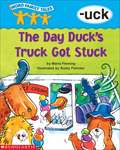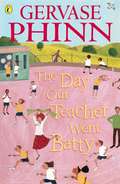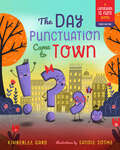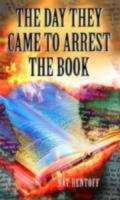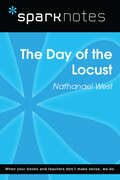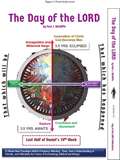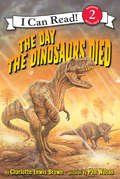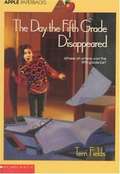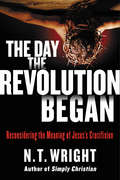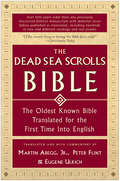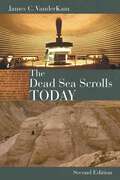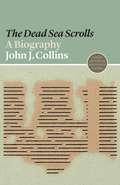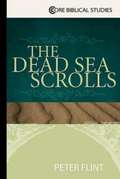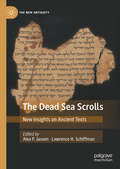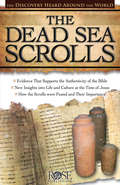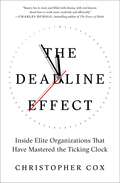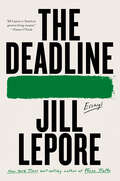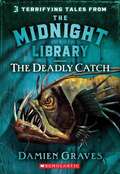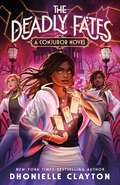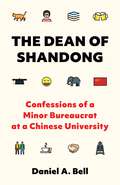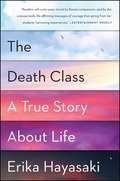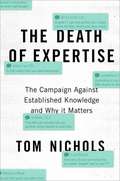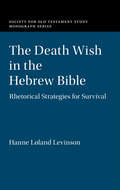- Table View
- List View
The Day Duck's Truck Got Stuck (Word Family Tales™ -uck)
by Rusty Fletcher Maria FlemingWord Family Tales are humorous read-aloud stories created to build early phonics skills by teaching children to recognize "families" of words that share the same spelling pattern. This key reading strategy helps kids decode new words with ease--and become stronger readers, writers, and spellers. Set learners on the path to literacy success with these rib-tickling tales--one for each of the top 25 word families! For use with Grades PreK-2.
The Day Our Teacher Went Batty
by Gervase PhinnA second collection of poems based on familiar themes.....
The Day Punctuation Came to Town (Language Is Fun! Ser. #2)
by Kimberlee GardRunner-up for the Reading the West Book Awards
The Day They Came To Arrest The Book (Laurel-Leaf Books)
by Nat HentoffWho would have believed that "The Adventure of Huckleberry Finn could cause the worst crisis in the history of George Mason High School? Certainly not Barney Roth, editor of the school paper. But when a small but vocal group of students and parents decide that the book is racist, sexist, and immoral--and should be removed from reading lists and the school library--Barney takes matters into his own hands. When the Huck Finn issue comes up for a hearing, Barney decides to print his story about previous censorship efforts at school. He's sure that investigative reporting and publicity can help the cause. But is he too late to turn the tide of censorship?
The Day of the Locust (SparkNotes Literature Guide Series)
by SparkNotesThe Day of the Locust (SparkNotes Literature Guide) by Nathanael West Making the reading experience fun! Created by Harvard students for students everywhere, SparkNotes is a new breed of study guide: smarter, better, faster. Geared to what today's students need to know, SparkNotes provides chapter-by-chapter analysis; explanations of key themes, motifs, and symbols; and a review quiz and essay topics. Lively and accessible, these guides are perfect for late-night studying and writing papers.
The Day of the Lord
by Paul J. WickliffeThe book, “The Day of the LORD” 1. An incomparable Bible prophecy masterpiece, “The Day of the LORD,” is the first of its kind in thirty years 2. The book, “The Day of the LORD,” eliminates all of the timing problems inherent in the other prophetic views currently in circulation: pre-tribulation; mid-tribulation; post-tribulation; neo post-tribulation; the pre-wrath rapture of the church; historicism and the heresy peddled by Hymenaeus and Philetus (II Tim. 2:17-19) better known as preterism 3. The author of the book, Paul Wickliffe, presents time as seen from eternity and God’s perspective—seamless and eternal, not sequential and temporal 4. Makes the distinction between national Israel and spiritual Israel (Rom. 2:28, 29 & Rom. 9:6, 7) 5. Reveals some of the imperceptible and incremental worldly influences, movements, and people labeled spiritual and ‘Christian,’ and the fruit these godless influences have had on society and biblical Christianity at large 6. Shows that Jesus’ Olivet Discourse (Matt. 24; Mark 13; Luke 21) has some profound elements ignored by most in the contemporary Bible prophecy camp: • That the tribulation and great tribulation are distinct periods of time. Jesus’ said otherwise in the phrase “those days.” Note, verses Matt. 24:19, 22, 29 • Contemporary prophecy says we are anticipating a period labeled the tribulation. Jesus said otherwise. We are in it! It began in the heart of national Israel when they rejected their Messiah. It was fulfilled in Jesus’ prophecy concerning Rome’s judgment in 70 A.D. on Jerusalem and giving us the Jewish Diaspora to the present • A failure to see prophecy from an eternal perspective and how ‘apparent’ sequential events are not actually sequential as told in the Olivet Discourse, some of the confusion by readers might begin to diminish. Once these chapters in Matthew 24, Mark 13, and Luke 21 are seen through an everlasting prism, the event described in Matthew 24:29-31, actually follows on the heels of the rapture in Matthew 24:37-41 • The term tribulation, a period of time we currently find ourselves, is not a future event. Being in it, this time period goes to the end of the 3.5 years, also known as the time of Jacob’s trouble 7. See why Daniel’s Seventieth Week has only three and a half years left not the seven years many Bible expositors claim (Dan. 9:27; Rev. 11:2, 3) 8. Understand the connection between Christ’s death on the cross and what that meant once Israel’s Passover Lamb had paid it all. See how all Jewish sacrifice and oblation were to become odious (offensive) to God, “and for the overspreading of abominations he shall make it desolate.” This meant animal atonement was empty, i.e. could not atone, or satisfy, God’s requirement in granting forgiveness 9. Examine a little-known truth regarding Simon Bar Kokhba (135 A.D.) and how he has been venerated and honored as Israel’s messiah 10. See the origin and explanation of the phrase “the day of the LORD,” and how that fits into God’s view of time, eternity, and prophecy 11. Has beautifully detailed graphs and charts not only showing the various prophetic views currently in circulation, but charts inclusive of other key eschatological events 12. See why Jesus’ words regarding his return in no way diminishes his deity. The key is in the word “knoweth” (Mark 13:32)
The Day the Dinosaurs Died (I Can Read Level 2)
by Charlotte Lewis BrownPresenting cutting-edge science to the youngest readers, The Day the Dinosaurs Died is a mesmerizing account of the end of the dinosaurs.The dinosaurs were the biggest, most powerful animals that ever walked the earth. Now they are all gone, extinct. Bold illustrations and a dramatic text re-create the devastation sixty-five million years ago when a giant asteroid slammed into Earth, triggering global disasters and leading to massive worldwide extinctions.The Day the Dinosaurs Died is a Level Two I Can Read, geared for kids who read on their own but still need a little help. Whether shared at home or in a classroom, the engaging stories, longer sentences, and language play of Level Two books are proven to help kids take their next steps toward reading success.
The Day the Eighth Grade Ran the School (Junior High #3)
by Kate KenyonWHAT'S THE POINT OF BEING AN EIGHTH-GRADER, IF YOU CAN'T MAKE SOME CHANGES? When Nora Ryan makes a list of complaints about school, she and her best friend Jennifer Mann discover they are not the only dissatisfied eighth- graders. The Gripe Revolution they set off does get results. For ONE day the principal puts the eighth grade in charge of Cedar Groves Junior High School. It's wonderful! What could possibly go wrong? Nora and Jennifer find out, long before the end of the unforgettable day that the eighth grade ran the school....
The Day the Fifth Grade Disappeared
by Terri FieldsOne minute, Julia is sitting in her fifth-grade classroom listening to a science lesson. The next minute, the entire class has vanished around her. Julia runs for help, but not one believes her--especially since the fifth grade is right where it's supposed to be when Julia returns.
The Day the Revolution Began: Reconsidering the Meaning of Jesus's Crucifixion
by N. T. WrightThe renowned scholar, Anglican bishop, and bestselling author widely considered to be the heir to C. S. Lewis contemplates the central event at the heart of the Christian faith--Jesus' crucifixion--arguing that the Protestant Reformation did not go far enough in transforming our understanding of its meaning.In The Day the Revolution Began, N. T. Wright once again challenges commonly held Christian beliefs as he did in his acclaimed Surprised by Hope. Demonstrating the rigorous intellect and breathtaking knowledge that have long defined his work, Wright argues that Jesus' death on the cross was not only to absolve us of our sins; it was actually the beginning of a revolution commissioning the Christian faithful to a new vocation--a royal priesthood responsible for restoring and reconciling all of God's creation. Wright argues that Jesus' crucifixion must be understood within the much larger story of God's purposes to bring heaven and earth together. The Day the Revolution Began offers a grand picture of Jesus' sacrifice and its full significance for the Christian faith, inspiring believers with a renewed sense of mission, purpose, and hope, and reminding them of the crucial role the Christian faith must play in protecting and shaping the future of the world.
The Dead Sea Scrolls Bible
by Martin G. AbeggFrom the dramatic find in the caves of Qumran, The Dead Sea Scrolls Bible presents the world's most precious and ancient version of the Bible. One thousand years older than any existing manuscripts, these scrolls allow us to read the Bible as it was in the time of Jesus. Preserving parts of all but one biblical book, the scrolls confirm that the text of the OldTestament as it has been handed down through the ages is largely correct. Yet, they also reveal numerous important differences. The Dead Sea Scrolls Bible presents all 220 of the Dead Sea biblical scrolls, arranged to be read in canonical order. Commentary by the editors provides insight into the rich cultural and religious traditions behind the scrolls and the Bible itself.
The Dead Sea Scrolls Today, rev. ed
by James VanderKamBest-selling book on the Scrolls, updated to reflect current scholarship and recent debates The premier Dead Sea Scrolls primer ever since its original publication in 1994, James VanderKam's Dead Sea Scrolls Today won the Biblical Archaeology Society's Publication Award in 1995 for the Best Popular Book on Biblical Archaeology. In this expanded and updated edition the book will continue to illuminate the greatest archaeological find in modern times. While retaining the format, style, and aims of the first edition, the second edition of The Dead Sea Scrolls Today takes into account the full publication of the texts from the caves and the post-1994 debates about the Qumran site, and it contains an additional section regarding information that the Scrolls provide about Second Temple Judaism and the groups prominent at the time. Further, VanderKam has enlarged the bibliographies throughout and changed the phrasing in many places. Finally, quotations of the Scrolls are from the fifth edition of Geza Vermes's translation, The Complete Dead Sea Scrolls in English (Penguin, 1997).
The Dead Sea Scrolls: A Biography (Lives of Great Religious Books #13)
by John J. CollinsSince they were first discovered in the caves at Qumran in 1947, the Dead Sea Scrolls have aroused more fascination--and more controversy--than perhaps any other archaeological find. They appear to have been hidden in the Judean desert by the Essenes, a Jewish sect that existed around the time of Jesus, and they continue to inspire veneration and conspiracy theories to this day. John Collins tells the story of the bitter conflicts that have swirled around the scrolls since their startling discovery, and sheds light on their true significance for Jewish and Christian history. Collins vividly recounts how a Bedouin shepherd went searching for a lost goat and found the scrolls instead. He offers insight into debates over whether the Essenes were an authentic Jewish sect and explains why such questions are critical to our understanding of ancient Judaism and to Jewish identity. Collins explores whether the scrolls were indeed the property of an isolated, quasi-monastic community living at Qumran, or whether they more broadly reflect the Judaism of their time. And he unravels the impassioned disputes surrounding the scrolls and Christianity. Do they anticipate the early church? Do they undermine the credibility of the Christian faith? Collins also looks at attempts to "reclaim" the scrolls for Judaism after the full corpus became available in the 1990s, and at how the decades-long delay in publishing the scrolls gave rise to sensational claims and conspiracy theories.
The Dead Sea Scrolls: A Canadian Collection (Studies In The Dead Sea Scrolls And Related Literature Ser. #Vol. 17)
by Peter W. FlintIn 1947, a Bedouin shepherd literally stumbled upon a cave near the Dead Sea, a settlement now called Qumran, to the east of Jerusalem. This cave, along with the others located nearby, contained jars holding hundreds of scrolls and fragments of scrolls of texts both biblical and nonbiblical—in Hebrew, Aramaic, and Greek. The biblical scrolls would be the earliest evidence of the Hebrew Scriptures, or Old Testament, by hundreds of years; and the nonbiblical texts would shed dramatic light on one of the least-known periods of Jewish history—the Second Temple period. This find is, quite simply, the most important archaeological event in two thousand years of biblical studies.The scrolls provide information on nearly every aspect of biblical studies, including the Old Testament, text criticism, Second Temple Judaism, the New Testament, and Christian origins. It took more than fifty years for the scrolls to be completely and officially published, and there is no comparable brief, introductory resource.Core Biblical Studies fulfill the need for brief, substantive, yet highly accessible introductions to key subjects and themes in biblical studies. In the shifting tides of biblical interpretation, these books are designed to help students locate relevant meanings in conversation with the text. As a first step toward substantive and subsequent learning, the series draws on the best scholarship in order to provide foundational concepts and contextualized information on a broad scope of issues, methods, perspectives, and trends.
The Dead Sea Scrolls: New Insights on Ancient Texts (The New Antiquity)
by Lawrence H. Schiffman Alex P. JassenThis volume draws readers into the exciting world of the Dead Sea Scrolls – around 930 manuscripts which were discovered in caves near the ancient settlement of Qumran between 1947 and 1956, and which transformed scholarship of the Bible, Judaism and Christianity. Ten scholars working at the forefront of their field address big-picture issues in relation to the scroll fragments, including their preservation and conservation; their availability electronically; and their relation to Rabbinic literature. The book also looks at the archaeology of Qumran, and the history and identity of the community; ancient writing systems; the scrolls in relation to the wider world of the time – the practice of magic and demonology, prayer, and colonial violence and power – as well as representations of them in popular media. The volume situates Dead Sea Scrolls scholarship within broader conversations in the study of the ancient world: Biblical Studies, Religious Studies, Classics, Archaeology, Jewish Studies, and Ancient History.
The Dead Sea Scrolls: The Discovery Heard Around the World
by J. Randall PriceThe discovery of the Dead Sea Scrolls is one of the most important archaeological finds ever for Christians. This find confirms that the Bible was translated accurately over the centuries. The scrolls also tell us about life at the time of Jesus and the New Testament. Dead Sea Scrolls includes the story of how the scrolls were discovered, a map, time line, photos of the caves where they were discovered and photos of the scrolls themselves.The Dead Sea Scrolls are a fascinating source of material regarding biblical times and the scrolls hold even greater importance to Christians. The Dead Sea Scrolls tell us: * The reliability of Old Testament translation over the years * Interesting information on the culture and times of Jesus Christ * What the people of Jesus' time expected from the Messiah The Dead Sea Scrolls examines the discovery of the oldest known copies of portions of the Old Testament. These ancient documents confirm the accuracy of modern Bible translations, but what were they doing hidden in caves in Qumran? Who were the people who hid them there? What do these scrolls reveal about Jewish history, the Old and New Testaments and early Christianity? The Dead Sea Scrolls investigates the amazing discovery. Includes a map of the region, a time line, and photos of caves and parchment scrolls. Includes insights on the Isaiah Scroll and other key discoveries. The pamphlet reveals: * What we know about the site * How the scrolls reveal the accuracy of Old Testament Bible translation over the centuries * What the scrolls reveal about Jewish history * What the scrolls reveal about early Christianity * What the scrolls reveal about the New Testament
The Deadline Effect: How to Work Like It's the Last Minute—Before the Last Minute
by Christopher CoxIn the tradition of Charles Duhigg&’s The Power of Habit, Christopher Cox&’s The Deadline Effect is a wise and counterintuitive book that explores the power of deadlines as uniquely effective tools of motivation and empowerment.Perfectionists and procrastinators alike agree—it&’s natural to dread a deadline. Whether your goal is to complete a masterpiece or just check off an overwhelming to-do list, the ticking clock signals despair. Christopher Cox knows the panic of the looming deadline all too well—as a magazine editor, he has spent years overseeing writers and journalists who couldn&’t meet a deadline to save their lives. After putting in a few too many late nights in the newsroom, he became determined to learn the secret of managing deadlines. He set off to observe nine different organizations as they approached a high-pressure deadline. Along the way, Cox made an ever greater discovery: these experts didn&’t just meet their big deadlines—they became more focused, productive, and creative in the process. In The Deadline Effect, Cox shares the strategies these teams used to guarantee success while staying on schedule: a restaurant opening for the first time, a ski resort covering an entire mountain in snow, a farm growing enough lilies in time for Easter, and more. Cox explains how readers can understand the psychological underpinnings of expectations and time, the dynamics of teams and customers, and techniques for using deadlines to make better, more assured decisions.
The Deadline: Essays
by Jill Lepore"Jill Lepore is unquestionably one of America’s best historians; it’s fair to say she’s one of its best writers too." —Jonathan Russell Clark, Los Angeles Times Best Books of 2023: New Yorker, TIME A book to be read and kept for posterity, The Deadline is the art of the essay at its best. Few, if any, historians have brought such insight, wisdom, and empathy to public discourse as Jill Lepore. Arriving at The New Yorker in 2005, Lepore, with her panoptical range and razor-sharp style, brought a transporting freshness and a literary vivacity to everything from profiles of long-dead writers to urgent constitutional analysis to an unsparing scrutiny of the woeful affairs of the nation itself. The astonishing essays collected in The Deadline offer a prismatic portrait of Americans’ techno-utopianism, frantic fractiousness, and unprecedented—but armed—aimlessness. From lockdowns and race commissions to Bratz dolls and bicycles, to the losses that haunt Lepore’s life, these essays again and again cross what she calls the deadline, the “river of time that divides the quick from the dead.” Echoing Gore Vidal’s United States in its massive intellectual erudition, The Deadline, with its remarkable juxtaposition of the political and the personal, challenges the very nature of the essay—and of history—itself.
The Deadly Catch (The Midnight Library #8)
by Damien Graves1. Adam and David go canoeing. Trouble awaits them in the water. The hungry kind of trouble. 2. Katie screams when she sees a mouse. And another one. And another one. And another one. 3. Kelly pursues a dream role in the school play. Offstage, her life is becoming a nightmare.
The Deadly Fates (The Conjureverse Series)
by Dhonielle Clayton"Another gripping entry in an engaging series that’s sure to keep readers hooked." —Kirkus Reviews Return to the world of the Marvellers and Conjurors in the third book of the instant New York Times and #1 Indie Bestselling fantasy series. Year Three at the global magic school in the sky is back in session in The Deadly Fates.After saving the world from the diabolical Ace of Anarchy, Ella, Brigit, and Jason return for year three at the Arcanum Training Institute. But the heroes' return is far from welcoming. Ella’s big reveal last year threw everything into chaos, unearthing long-buried secrets and unwinding a twisted trail of deceit. As tensions rise between Marvellers and Conjurors, Ella realizes that the only way to end the chaos is to unveil the truth about what happened to the Conjure architect once and for all. To do that, she’ll have to enlist the help of the living and the dead. As they plunge deeper into the truth, the search leads them to the Underworld and the Cards of Deadly Fate—an impenetrable prison for supervillains. But before Ella can figure out how it’s all connected, the tension between magical worlds boil over, threatening everyone around her. Will Ella and her friends uncover the truth about the missing architect before their worlds collide?
The Dean of Shandong: Confessions of a Minor Bureaucrat at a Chinese University
by Daniel A. BellA Financial Times Best Book of the YearAn inside view of Chinese academia and what it reveals about China&’s political systemOn January 1, 2017, Daniel Bell was appointed dean of the School of Political Science and Public Administration at Shandong University—the first foreign dean of a political science faculty in mainland China&’s history. In The Dean of Shandong, Bell chronicles his experiences as what he calls &“a minor bureaucrat,&” offering an inside account of the workings of Chinese academia and what they reveal about China&’s political system. It wasn&’t all smooth sailing—Bell wryly recounts sporadic bungles and misunderstandings—but Bell&’s post as dean provides a unique vantage point on China today.Bell, neither a Chinese citizen nor a member of the Chinese Communist Party, was appointed as dean because of his scholarly work on Confucianism—but soon found himself coping with a variety of issues having little to do with scholarship or Confucius. These include the importance of hair color and the prevalence of hair-dyeing among university administrators, both male and female; Shandong&’s drinking culture, with endless toasts at every shared meal; and some unintended consequences of an intensely competitive academic meritocracy. As dean, he also confronts weightier matters: the role at the university of the Party secretary, the national anticorruption campaign and its effect on academia (Bell asks provocatively, &“What&’s wrong with corruption?&”), and formal and informal modes of censorship. Considering both the revival of Confucianism in China over the last three decades and what he calls &“the Communist comeback&” since 2008, Bell predicts that China&’s political future is likely to be determined by both Confucianism and Communism.
The Death Class: A True Story About Life
by Erika HayasakiThe poignant, “powerful” (The Boston Globe) look at how to appreciate life from an extraordinary professor who teaches about death: “Poetic passages and assorted revelations you’ll likely not forget” (Chicago Tribune).Why does a college course on death have a three-year waiting list? When nurse Norma Bowe decided to teach a course on death at a college in New Jersey, she never expected it to be popular. But year after year students crowd into her classroom, and the reason is clear: Norma’s “death class” is really about how to make the most of what poet Mary Oliver famously called our “one wild and precious life.” Under the guise of discussions about last wills and last breaths and visits to cemeteries and crematoriums, Norma teaches her students to find grace in one another. In The Death Class, award-winning journalist Erika Hayasaki followed Norma for more than four years, showing how she steers four extraordinary students from their tormented families and neighborhoods toward happiness: she rescues one young woman from her suicidal mother, helps a young man manage his schizophrenic brother, and inspires another to leave his gang life behind. Through this unorthodox class on death, Norma helps kids who are barely hanging on to understand not only the value of their own lives, but also the secret of fulfillment: to throw yourself into helping others. Hayasaki’s expert reporting and literary prose bring Norma’s wisdom out of the classroom, transforming it into an inspiring lesson for all. In the end, Norma’s very own life—and how she lives it—is the lecture that sticks. “Readers will come away struck by Bowe’s compassion—and by the unexpectedly life-affirming messages of courage that spring from her students’ harrowing experiences” (Entertainment Weekly).
The Death Of Expertise
by Tom Nichols9780394577456Technology and increasing levels of education have exposed people to more information than ever before.9780394577456 These societal gains, however, have also helped fuel a surge in narcissistic and misguided intellectual egalitarianism that has crippled informed debates on any number of issues.9780394577456 Today, everyone knows everything: with only a quick trip through WebMD or Wikipedia, average citizens believe themselves to be on an equal intellectual footing with doctors and diplomats.9780394577456 All voices, even the most ridiculous, demand to be taken with equal seriousness, and any claim to the contrary is dismissed as undemocratic elitism.9780394577456 Tom Nichols' The Death of Expertise shows how this rejection of experts has occurred: the openness of the internet, the emergence of a customer satisfaction model in higher education, and the transformation of the news industry into a 24-hour entertainment machine, among other reasons. 9780394577456Paradoxically, the increasingly democratic dissemination of information, rather than producing an educated public, has instead created an army of ill-informed and angry citizens who denounce intellectual achievement. 9780394577456When ordinary citizens believe that no one knows more than anyone else, democratic institutions themselves are in danger of falling either to populism or to technocracy or, in the worst case, a combination of both.9780394577456 An update to the 2017breakout hit, the paperback edition of The Death of Expertise provides a new foreword to cover the alarming exacerbation of these trends in the aftermath of Donald Trump's election.9780394577456 Judging from events on the ground since it first published, The Death of Expertise issues a warning about the stability and survival of modern democracy in the Information Age that is even more important today.
The Death Wish in the Hebrew Bible: Rhetorical Strategies for Survival (Society for Old Testament Study Monographs)
by Hanne Løland LevinsonThis is the first book to systematically investigate the texts in the Hebrew Bible in which a character expresses a wish to die. Contrary to previous scholarship on these texts that assumed these death wishes were simply a desire to escape suffering, Hanne Løland Levinson employs narrative criticism and conversation analysis, together with diachronic methods, to carefully hear each death-wish text in its literary context. She demonstrates that death wishes embody powerful, multi-faceted rhetorical strategies. Grouping the death-wish texts into four main rhetorical strategies of negotiation, expression of despair and anger, longing to undo one's existence, and wishing for a different reality, Løland Levinson portrays the complex reasons why characters in the Hebrew Bible wish for death. She concludes that the death wishes navigate the tension between longing for death and fighting for survival - a tension that many live with also today as they attempt to claim agency and autonomy in life.
The Death and Life of the Great American School System
by Diane RavitchA passionate plea to preserve and renew public education, The Death and Life of the Great American School System is a radical change of heart from one of America's best-known education experts. Diane Ravitch--former assistant secretary of education and a leader in the drive to create a national curriculum--examines her career in education reform and repudiates positions that she once staunchly advocated. Drawing on over forty years of research and experience, Ravitch critiques today's most popular ideas for restructuring schools, including privatization, standardized testing, punitive accountability, and the feckless multiplication of charter schools. She shows conclusively why the business model is not an appropriate way to improve schools. Using examples from major cities like New York, Philadelphia, Chicago, Denver, and San Diego, Ravitch makes the case that public education today is in peril. Ravitch includes clear prescriptions for improving America's schools: leave decisions about schools to educators, not politicians or businessmen devise a truly national curriculum that sets out what children in every grade should be learning expect charter schools to educate the kids who need help the most, not to compete with public schools pay teachers a fair wage for their work, not "merit pay" based on deeply flawed and unreliable test scores encourage family involvement in education from an early age The Death and Life of the Great American School System is more than just an analysis of the state of play of the American education system. It is a must-read for any stakeholder in the future of American schooling.
